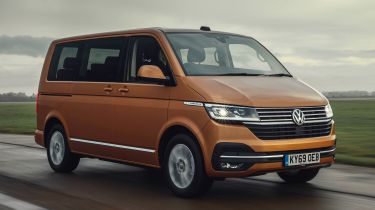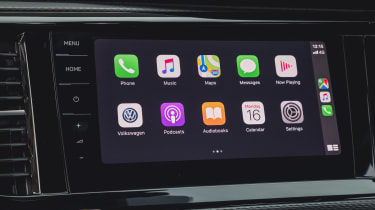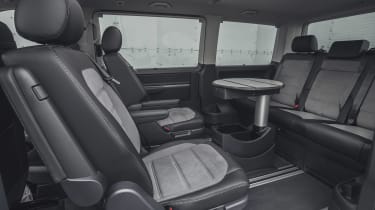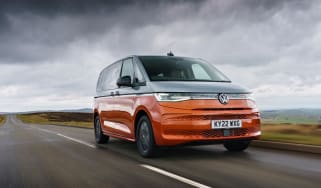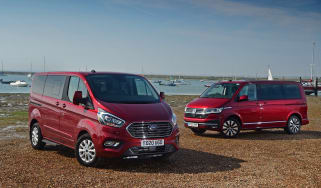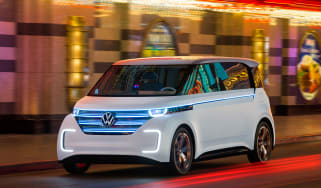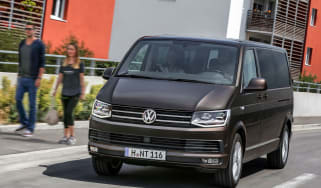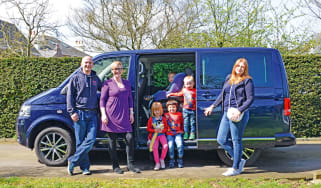Volkswagen Caravelle (2015-2022) review
If you can afford one, the Volkswagen Caravelle is a fantastic 7-seat utility vehicle for business or private use

The Volkswagen Caravelle might be based on the Transporter van but it successfully disguises those workmanlike roots with a spacious, business class interior boasting an array of advanced technology and practical features. As a means of transporting 7 adults and their luggage in comfort over long distances it has few rivals, but the Caravelle doesn’t come cheap.
The popularity of MPVs with private car buyers has waned over the last decade or so. These functional people carriers were once a common sight on the roads but the rise in popularity of 7-seat SUVs drew style-conscious family buyers away.
Today, there are far fewer MPV options to choose from as a result, and a large proportion of those that do remain are based on commercial vehicle underpinnings. The thought of running a glazed van as a family car is anathema to many people but you can’t beat these vehicles for sheer space and practicality.
The Volkswagen Caravelle sits right at the pinnacle of this van-based MPV niche, justifying its premium price tag with a spacious and versatile interior that rivals many executive saloons in terms of opulence and tech. It’s an ideal solution for luxury taxi fleets or business class airport transfers, but big families might also consider the Caravelle as a roomier alternative to that 7-seat luxury SUV they were considering.
Used - available now

2023 Ford
Kuga
15,421 milesManualPetrol1.5L
Cash £22,899
2024 BMW
3 Series Touring
39,127 milesAutomaticPetrol2.0L
Cash £25,999
2021 MINI
3-Door Hatch
28,695 milesManualPetrol1.5L
Cash £13,649
2022 Toyota
C-HR
24,378 milesAutomaticPetrol1.8L
Cash £19,599The latest VW Caravelle is known as the 6.1 iteration, essentially a facelifted version of the model based on the T6 Volkswagen Transporter van that was launched in 2015. Changes brought in at the time of the facelift run to new headlights with little chrome ‘Caravelle’ badges that extend a few inches along into the front wings, a redesigned grille and an updated interior with the latest infotainment technology. The old hydraulic power steering system has been swapped out for an electro-mechanical set-up that allows a series of advanced driver assistance features and, according VW, also boosts fuel economy.
The Caravelle is available with a pair of 2.0-litre diesel engine options, the TDI 150 with 148bhp and the twin-turbo TDI 199 with 196bhp. Both get a 7-speed DSG automatic gearbox and while all models are front-wheel drive as standard, the more powerful engine can be ordered with 4Motion all-wheel drive if buyers feel they may need it.
Beyond that there are short and long wheelbase options plus a couple of trim levels - SE and Executive. Even the standard Caravelle SE gets 16-inch alloy wheels, a 6.5-inch touchscreen infotainment system, adaptive cruise control and, of course, the Caravelle’s rail-based seating system with its 3-seat rear bench, a table and two rotating chairs in the centre of the cabin.
How much does the Volkswagen Caravelle cost?
You’ll pay over £47,000 for the cheapest Volkswagen Caravelle and a fully-loaded one will extend up to and over the £60,000 mark. The obvious rivals are the slightly more affordable but less salubrious Citroen SpaceTourer and Peugeot Traveller van-based MPV twins or, the Caravelle’s long-standing arch rival, the Mercedes V-Class - itself based on the Mercedes Vito panel van. As we’ve said though, the big VW could also be seen by some as an alternative to large 7-seat luxury SUVs like the Volvo XC90 and Mercedes GLS.
Engines, performance and drive
If you’re worried about the VW Caravelle seating your most important clients atop a van chassis designed primarily to transport inanimate cargo, don’t be. Firstly, the Volkswagen Transporter is one of the smoothest riding vehicles in the mid-sized panel van class and secondly, VW engineers have comprehensively retuned the Caravelle’s suspension for the express purpose of keeping demanding occupants onside.
The ride is good even by passenger car standards with the cabin well isolated from bigger bumps and potholes. A downside of this softness is that occupants can experience a background wobble on some surfaces but despite this, the vehicle never feels floaty or disconnected from the road over undulations. Attempt to corner the Caravelle too briskly and you’ll be warned off by the pronounced body roll long before the CEO in the back seat tells you to calm down but the electronic power steering system is accurate enough and at low speeds the Caravelle is surprisingly maneuverable. Parking and reversing are aided by the high driving position giving great all-round visibility and the array of driver aids that we’ll touch on later.
Also in the interests of ensuring occupants arrive at their destination feeling refreshed, the Caravelle has far lower noise levels that the van it shares a platform with. There are thuds from the suspension on poor surfaces but at motorway cruising speeds the engine is almost inaudible and road noise is well muted. There’s quite a bit of wind noise around those generous door mirrors as speeds creep up and asking the gearbox to kick down for a burst of acceleration will bring a muffled roar from the engine bay. General refinement, though, is better than you would expect - if not on a par with the bast premium SUVs and saloons cars.
Engines, 0-60 acceleration and top speed
It’s the VW Group’s ubiquitous 2.0-litre diesel engines all the way for the Caravelle. That means entry-level buyers get the TDI 150 with 148bhp and 340Nm of torque between 1,500 and 3,000rpm. It’s not what you would call quick, partly as a result of the basic car’s 2,330kg kerb weight, but the Caravelle doesn’t reward spirited driving anyway. The 0-62mph takes 13 seconds but there’s a 112mph top speed and the vehicle has no trouble dicing with motorway traffic.
Opt for the BiTDI 199 twin-turbo engine and you get 196bhp plus 450Nm between 1,400 and 2,400rpm. The 0-62mph time is reduced to 10.1 seconds, or 10.3 seconds if you also choose 4Motion all-wheel drive, and the top speed rises to 124mph. With both engines, the DSG gearbox is smooth and shifts are almost unnoticeable if you fall into that easy-going driving style that suits the Caravelle best.
MPG, CO2 and Running Costs
There’s very little to choose between the two engines in terms of economy and emissions. The TDI 150 unit produces 166g/km of CO2 in Executive trim while the TDI 199 only pumps out 168g/km in equivalent spec. On the WLTP combined cycle, the official numbers are between 31.7 and 33.6mpg for the TDI 150 and between 31.7 and 34.0mpg for the TDI 199, all of which makes the extra thrust of the flagship engine more attractive.
Both of the VW Caravelle’s engines are compliant with the Euro 6d emissions regulations and use SCR (Selective Catalytic Reduction) technology to clean their exhaust emissions with injections of AdBlue from a 13-litre onboard tank. The Diesel Particulate Filter (DPF) also has a novel feature that will be of use to Caravelle buyers spending most of their time in urban areas. At speeds below 25mph the automatic cleansing of the DPF doesn't kick in but an optional button in the cabin lets the driver manually engage the cleaning function to burn off the collected soot particles - just check your mirrors first.
Insurance groups
Insurance groups for the Caravelle kick off at 24E for the short wheelbase TDI 150 variant in SE trim. You’ll step up to 25E for the long wheelbase model while the BiTDI 199 variant sits in group 31E or as high as 33E for the top spec Executive model. By way of comparison, the Mercedes V-Class sits a little higher in groups 37 to 46 for the 236bhp flagship models.
Depreciation
The Volkswagen Caravelle holds its value extremely well and the strong residuals will go a long way towards offsetting the somewhat steep list prices for the vehicle.
To get an accurate valuation on a specific model check out our free car valuation tool...
Interior, design and technology
The Caravelle’s designers have tiptoed expertly along the fine line between commercial vehicle utility and passenger car plushness. The exterior lines are clean and unremarkable with the key details marking out the latest Caravelle 6.1 model being the revised headlights, with their wing-mounted model designation tags, and the reshaped grille.
Inside, the switchgear and technology is that of the latest VW passenger car range and the materials are of a decent quality, but you also get the durable build you’d expect in a van plus the wide range of storage options.
All models get analogue instruments with a colour multifunction display at the centre providing extra driving information, but there’s the option to upgrade to a full 10.25-inch digital display with the Discover Pro infotainment system. Different display modes can be selected by clicking the view button on the multi-function steering wheel so that drivers can choose their preferred combination of trip, navigation and driving information on the display.
The SE models get Adaptive Cruise Control, semi-automatic air-conditioning, electric heated mirrors, sun blinds for the rear side windows and 2 USB sockets. Volkswagen has chosen to go with type C USB connectors so you’ll need an adapter to use devices with a standard USB interface.
On Executive trim cars the standard 16-inch alloy wheels are upgraded to 17-inch items, LED headlights and tail lights are added and so are fog lights with a cornering light function that swivels them to illuminate bends. Inside, there’s a 3-zone climate control system so you can set different temperatures in different rows, a rear parking camera and a centre armrest is added to the 3-seat rear bench.
Sat-nav, stereo and infotainment
There are three infotainment systems on the Caravelle. The first, standard on SE models, is the Composition Colour system with its 6.5-inch colour touchscreen display bordered by physical buttons for the major menus. There’s Apple CarPlay and Android Auto as standard plus compatibility with the VW We Connect suite of app-based services which let you perform all manner of useful tasks from locking and unlocking the Caravelle remotely via your phone to pre-setting navigation routes.
Move up to the Discover Media system that’s included on Executive models and you get a larger 8-inch screen. You also get built-in satellite navigation at this level and 32GB of media storage space. The final step is the Discover Pro system that comes with the digital instrument cluster and replaces all the physical buttons. In all cases, the VW systems offer clear graphics and well ordered menus, they’re up with the very best infotainment systems on the market and you won’t find better in a van-based MPV.
Practicality, comfort and boot space
The basic VW Caravelle cabin layout is the same across the range. You get a pair of fixed, forward facing seats in the front, then two rotating arm chairs in the middle row and a 3-seat bench making up the third row. Sitting in the middle is a multi-function table that folds out and contains various cup holders and storage options. With all of the second and third row elements mounted on sturdy rails cut into the Caravelle’s floor, they can be slid back and forth to configure the cabin in various different ways and give the Caravelle its outstanding flexibility.
Dimensions and size
This is a large vehicle by passenger car standards. Short wheelbase derivatives are 4,904mm long and the long wheelbase ones stretch to 5,304mm. All Caravelles are 2,297mm wide from door mirror tip to door mirror tip and just shy of 2 meters tall. In terms of weight, the heaviest 4Motion 4x4 models are 2,495kg and even the lightest model in the range is 2,330kg.
Leg room, head room & passenger space
Space is never in short supply in a Caravelle. The driving position is very high and with a height adjustable seat you can get a great view out of the vehicle, no matter how tall you are. Headroom is abundant in all the seats and there’s a real feeling of spaciousness that passenger carrying vehicles without commercial vehicle origins simply can’t match.
Moving the rear seats around on their rail system is simple enough but they are extremely heavy so it’s not advisable to try and lift them out of the car single handed. The central table can also get in the way when you’re trying to move the seats so you soon learn to shift this out of the way first.
Access to the rear is via the powered sliding side doors that open very wide even in the tightest of spaces. It means that there’s absolutely no problem climbing into the third row seats, unlike in most other 7-seater passenger cars.
Boot space
The Caravelle’s boot space depends on your choice of short or long wheelbase and on how you’ve chosen to configure the interior. The beauty of the rail-based seating system is that you can sacrifice boot capacity for more legroom or visa versa. As we’ve said, the seats don’t fold flat to the floor but you can fold the seat backs down or lift the seats out entirely, returning the Caravelle to a van-like configuration with a huge load area. You can carry payloads of between 587kg and 670kg depending on the model. In terms of actual boot volume though there are some things to be aware of. Loading couldn’t really be easier thanks to the huge slab-like tailgate and the low loading floor but bear in mind that you’ll need a lot of space behind the vehicle to get that tailgate open.
In addition, particularly in the short wheelbase models, the luggage space behind the rear seats is very shallow. You’ll need to stack luggage up to get large amounts inside and then you risk it toppling out when you reach your destination and open the tailgate. Ultimately though, if you want to carry 7 adults and luggage, there’s little short of a full-blown minibus to touch the Caravelle.
Towing
If the interior space is insufficient, you can always hitch up a trailer and pull some extra capacity along behind. All versions of the Caravelle can tow a 2,500kg brakes trailer - or a 750kg unbraked one.
Reliability and Safety
The latest Caravelle comes with a comprehensive list of safety kit as standard, there’s ESC stability control, Hill Start Assist, Tyre pressure monitors, automatic emergency braking, auto-dipping main beam headlights and the ParkPilot auto parking functionality. On the latest models, the switch to electro-mechanical steering has enabled the addition of Cross Wind Assist, which works to keep the Caravelle steady when gusts of wind come from the sides, lane keeping assist, and trailer assist, which lets you reverse a trailer looking back out of the side window and using the side mirror adjustment joystick to steer the vehicle. There’s traffic sign recognition and a full suite of proximity sensors to help you when maneuvering as well. The Caravelle has yet to feature in our Driver Power reliability survey but Volkswagen itself has. The brand ranked a mid-table 17th in the 2019 poll. Likewise, the Caravelle has yet to have its date with the crash testers at Euro NCAP.
Warranty
The Caravelle gets the standard VW warranty of 3-years or 100,000 miles. The vehicle is sold through VW van centres which are focused on getting vehicle back on the road in good time so warranty and other work should be performed promptly.
Servicing
Fixed price servicing deals are available through VW’s van centres and these should help you manage running costs with a simple, predictable monthly fee. Prices range from £16 a month for basic servicing to £48 per month for all servicing, maintenance and tyres.
